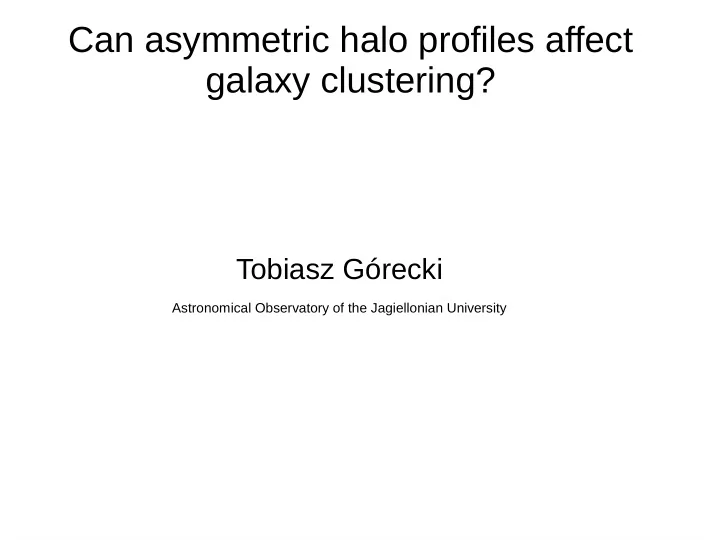

Can asymmetric halo profiles affect galaxy clustering? Tobiasz Górecki Astronomical Observatory of the Jagiellonian University
Outline 1. Introduction: are dark matter haloes symmetric or asymmetric? 2. How can the shape of the dark matter haloes affect galaxy clustering measurements? 3. Halo asymmetry from the SDSS data.
Introduction: are dark matter haloes symmetric or asymmetric? Measure asymmetry DM halo for galaxy DIRECT OBSERVATIONS COSMOLOGICAL SIMULATIONS -strong gravitational lensing e.g. MultiDark Planck simulations -weak gravitational lensing
Cosmological simulations ● We use cosmological DM simulation SMDPL (The Small MultiDark Planck simulation, Klypin et al. 2014). ● Total number of particles using in SMPLS is 3840^3 with ∗ mass resolution 9.63 10^7 M /h within box size 400 Mpc/h. ● In this simulation, dark matter halos are identified (FoF) and halo shapes estimated (by an algorithm based on inertia tensor, Allgood et al. 2006). b/a - the ratio of the second largest shape ellipsoid axis to the largest shape ellipsoid axis a/c – the ratio of the smallest shape ellipsoid axis to the largest shape ellipsoid axis
Cosmological simulations DM haloes are triaxial ellipsoids. The asymmetry components b/a and c/a of a DM halo as a function of dark halo mass in subsequent redshift bins for 0<z<1.26. Asymmetry rises with halo mass.
Cosmological simulations The asymmetry components b/a and c/a of a DM halo as a function of redshift in subsequent halo mass bins for 10.5<log(M_{halo})<14.5. Asymmetry rises with redshift as well .
Cosmological simulations Ratios (b/a) and (c/a) as a function of redshift 0<z<1.26 Conclusions from cosmological simulations(SMDPL): -asymmetry of dark matter haloes strongly depends on halo mass and redshift -for z=0-0.2 a component c/a changes with redshift much more rapidly than a component b/a; we can then assume a component b/a to be roughly constant
Theoretical model for NFW dark matter profile asymmetric in one direction R/η a R NFW dark matter halo profile
Galaxy Correlation Function - the most convenient measure of galaxy clustering In the first approximation correlation function can be In the first approximation correlation function can be fit by a power law fit by a power law Correlation function describes the excess probability of finding a pair of galaxies, as the function of separation, compared to a random distribution (e.g. Peebles 1980). HOD modeling Pollo et al. 2005
Standard HOD modeling 5 ingredients to describe Halo Occupation Distribution model: a) halo mass function b) halo bias c) halo occupation distribution d) clustering of dark matter e) dark matter halo profile(usually defined by the NFW symmetric profile) NFW dark matter halo profile 5 free parameters -to describe the halo occupation distribution statistic
How can an assymetry of the halo profile possibly affect galaxy clustering? We develop a 6 parameter HOD model based on an asymmetric NFW profile. We then fit it to the the SDSS data (Zehavi et al. 2011) and compare the results to the 5 parameter model.
Increasing asymmetry affects significantly (and mainly) one halo term M_r<18.0 z=0.043 HOD fit for the SDSS CF: fixed HOD parameters as computed by Zehavi 2011 but with a changing asymmetry
HOD modelling with asymmetrical NFW dark matter profile for SDSS data: at low z we obtain the best fit for a practically symmetric halo M_r<-18.0 z=0.043 Results for 5 parameters Fixed at the values given by Zehavi(2011): asymmetry can improve the fit. Fitting all 6 parameters Independently gives Very similar result Asymmetric NWF profile: Best fitted η=0.98 Best fit for a symmetric NWF profile η=1 HOD fit of SDSS:(CF from Zehavi et al. 2011): but for the lowest z and faint luminosities the best fit corresponds to an almost negligible asymmetry .
Asymmetry parameter η rises with z for SDSS as a function of luminosity z=0.245 Z=0.106 Z=0.042 For the SDSS data, the best fitted asymmetry parameter η rises with limiting sample luminosity (and corresponding median z of a sample)
CONCLUSIONS 1. Cosmological simulations (and some observations) indicate that galaxy haloes may be not spherical, with the asymmetry rising with resdhift and halo mass. 2. This may affect the measurements based on the HOD modeling of the galaxy correlation function, usually based on the symmetric NWF dark halo density profile. 3. We implemented a non-spherical NFW halo profile to the HOD (resulting in a 6 parameter model). 4. The asymmetric NFW profile affects mainly the one halo term of the correlation funtion. 5. Fitting our model to the SDSS data at 0<z<0.245 we found that: a)For the lowest redshifts and faintest limiting sample luminosities (z ~ 0, M_r<-18) CF is best fitted by an HOD model with a symmetric halo profile.. b) At brighter limiting magnitudes and higher redshifts, the asymmetry has a growing effect on the galaxy CF shape, reaching η=1.08 for M_r<-22 (z=0.245). 6. The asymmetry of DM halo profiles may have an significant effect on the measurements of the galaxy clustering, especially at higher redshifts. 7. Next steps: (a) more massive tests on simulations (b) disentangle redshift and luminosity dependence at low z, (c) perform an HOD fit with a non-spherical dark matter profile e.g. to the VIPERS z~0.8 data.
Recommend
More recommend